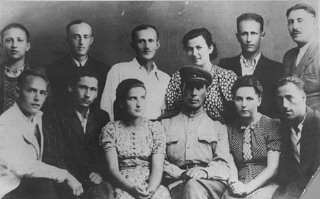It is most timely that I should talk about this!
Sobibór was one of the Third Reich’s six death camps, all of which were in Axis‐occupied Poland. It was in operation from April 1942 to October 1943, and tragically took the lives of at least 167,000 people. Nevertheless, the daring uprising here can serve as an important lesson and inspiration to all of us:
In the summer of 1943, the Sobibór killing center saw a decline in the number of victims sent to be murdered in its gas chambers. This sparked a rumor among the prisoners forced to labor in Sobibór that the killing center would soon be dismantled and all the prisoners murdered. A group of Polish Jews led by Leon Feldhandler formed a secret committee to plan a mass escape. However, its members lacked any military experience and made little progress.
When a group of Jewish Red Army POWs arrived in a transport from Minsk in September, the committee turned to them for advice. Within three weeks, Lieutenant Alexander Pechersky worked out a detailed plan. First, the Soviet POWS would secretly kill some of the SS officials, taking their weapons and uniforms.
Then, when the approximately 600 prisoners assembled for evening roll call, the POWs masquerading as camp personnel would kill the guards at the gate and on the towers and urge the prisoners to flee. The revolt was set for a day when Sobibór’s commandant and several of its leading officials would be away.
The Uprising
The uprising began around 4:00 in the afternoon of October 14, 1943. In Camp One, prisoners invited the deputy commandant, Johann Niemann, into the tailor shop to be fitted for a suit. They then killed him with an axe. In Camp Two, prisoners lured SS NCO Josef Wulf to try on a coat in the warehouse of victims’ belongings, and also killed him with an axe. In the course of the next hour or so, nine more SS personnel were killed in a similar manner.
As the prisoners gathered for roll call, however, the remaining camp personnel became alarmed and opened fire on the prisoners. While members of the camp resistance who had obtained arms returned fire, over 300 prisoners fled from the camp.
Many prisoners were shot during the escape or died in the minefields around the camp. At least 100 others were caught and killed during the massive manhunt conducted by SS, police, and [Axis] army units in the days following the uprising.
Of the perhaps 200 escapees who were not immediately caught, only about 50 survived the war, often with the help of the local population or by joining partisan groups. On the other hand, many of the escapees who did not survive were betrayed to the [Fascists] or killed by Polish civilians or partisans.
In the end, prisoners killed eleven members of Sobibór’s SS staff as part of the planned escape. Two or more non‐German SS auxiliary guards who were in the wrong place at the wrong time were also killed. All of the prisoners remaining in Sobibór—some of whom continued to fight with guns and axes throughout the night—were shot by the end of the following day on October 15.
(Emphasis added.)
Soon afterwards, the SS ordered prisoners from Treblinka to dismantle the camp and it was out of operation for good. Victims of the uprising included SS officer Rudolf Beckmann, Axis sergeant Siegfried Graetschus, and Axis lieutenant Johann Niemann.
Other events that happened today (October 14):
1888: Yukio Sakurauchi, Imperial Minister of Commerce and Industry, was born.
1909: Mochitsura Hashimoto, Axis submarine commander, and Bernd Rosemeyer, Hauptsturmführer, were both delivered to the world.
1930: The fascist Lapua Movement kidnapped former and first President of Finland, K. J. Ståhlberg, and his wife, Ester Ståhlberg, from their home.
1933: The Third Reich withdrew from the League of Nations and World Disarmament Conference.
1939: The Axis submarine U‐47 sunk the British battleship HMS Royal Oak within her harbour at Scapa Flow, Scotland.
1940: The London Blitz destroyed the Balham underground station, massacring sixty‐six people.
1943: The Second Philippine Republic, an Axis collaborationist régime, inaugurated with José P. Laurel as its president. Meanwhile, the Axis took out sixty of the United States Eighth Air Force’s 291 B‐17 Flying Fortresses during the Second Raid on Schweinfurt.
1944: Johannes Erwin Eugen Rommel, Axis field marshal (who served an important rôle in controlling North Africa), committed suicide.
2002: Norbert Arnold Wilhelm Richard Schultze, Fascist musician, died.



deleted by creator